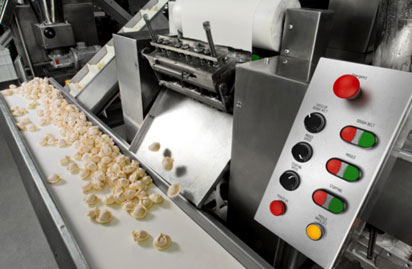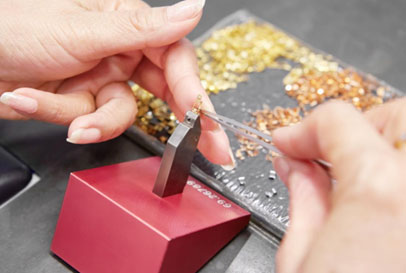Benefits of Gold-Plated vs. Silver Contacts
In Electrical Pushbuttons, Lever Switches, Keylock Switches, Emergency- and Stop Switches
In electrical pushbuttons and various switches, including emergency stop switches, the choice of contact materials is crucial for ensuring optimal performance, reliability, and durability. Gold and silver are among the most utilized materials for contacts. Each offers distinct benefits, and the selection of the most suitable one is contingent upon the specific application and the operating conditions of the switch. This blog examines the advantages of gold-plated contacts in comparison to silver, particularly in the context of Human-Machine Interfaces (HMIs) across a range of applications, from low-level signal circuits to high-load industrial machinery.
 Automated machinery with switches and push-buttons for HMI. (Image source: EAO)
Automated machinery with switches and push-buttons for HMI. (Image source: EAO)
Overview of Silver and Gold-Plated Contacts
Silver Contacts
Silver is an exceptionally conductive material, which makes it ideal for use in electrical contacts - especially in high-power applications. It is commonly utilized in scenarios that demand high current, including industrial machinery, power switches, and appliance switches. Nevertheless, silver has a significant disadvantage: it is prone to oxidation when exposed to air and moisture. This oxidation can lead to increased contact resistance, ultimately diminishing the reliability of the switch over time, particularly in low-load situations.
Gold-Plated Contacts
Gold exhibits remarkable resistance to corrosion and provides outstanding conductivity at low voltages. When applied as a plating material over a substrate like silver, gold effectively inhibits oxidation, thereby maintaining a clean and stable connection over extended periods. Gold-plated contacts are particularly suited for low-level applications where precision and reliability are critical like in signal processing, control panels, and audio-video equipment.
 Gold is generally superior to silver for contact plating applications. (Image source: EAO)
Gold is generally superior to silver for contact plating applications. (Image source: EAO)
Performance Comparison: Gold-Plated vs. Silver Contacts
High-Level Applications
Silver contacts are exceptionally efficient for applications involving medium to high voltages typically around 20 V and above and currents reaching up to 10 A. Silver's capacity to manage these substantial loads guarantees both effective and dependable operation. Additionally, any oxidation that develops on silver contacts is frequently "electrically cleaned" by the substantial current flow which effectively removes the oxidation layer. This self-cleaning property enables silver contacts to sustain their performance even in conditions of significant electrical stress.
Typical Applications:
- Industrial machinery switches
- High-power appliance switches
- Direct switching circuits
 Silver is more suitable for higher voltage and current applications. (Image source: EAO)
Silver is more suitable for higher voltage and current applications. (Image source: EAO)
Low-Level Applications
For applications involving lower levels, such as signal processing circuits and voltages under approximately 20 V, silver contacts may not be sufficient due to their propensity to oxidize. When operating with low currents, these contacts do not possess enough energy to penetrate the oxidation layer thus resulting in inconsistent switching performance. In these scenarios, gold-plated contacts present a significant benefit. Gold is inert and resistant to oxidation which helps maintain a clean surface and ensures reliable low-resistance switching even at lower currents and voltages.
Typical Applications:
- Control signals for machinery
- Outdoor remote control systems with E-Stops
- Instrumentation switches
- Audio and video equipment
 Gold-plated contacts are more suitable for lower voltage and current applications. (Image source: EAO)
Gold-plated contacts are more suitable for lower voltage and current applications. (Image source: EAO)
Benefits of Gold-Plated Contacts
- Oxidation Resistance
- Reliability in Polluted and Humid Environments
- Low-Level Signal Switching
The primary advantage of gold-plated contacts lies in their exceptional resistance to corrosion and oxidation. In contrast to silver contacts, which develop an oxidation layer over time that can increase contact resistance, gold does not oxidize. This characteristic renders gold-plated contacts especially important in low-level signal applications where even slight increases in contact resistance can interfere with circuit functionality.
Gold-plated contacts are well-suited for use in challenging environments characterized by moisture, dust, and various pollutants. In these conditions, silver contacts tend to oxidize quickly whereas gold contacts maintain their performance without deterioration. Consequently, gold-plated contacts are often the preferred option for switches used in outdoor applications or industrial settings that face exposure to environmental contaminants.
Gold-plated contacts are ideal for applications that require low voltage and low current. Such applications encompass control systems, precision instruments, and audio-video equipment where it is essential to preserve signal integrity and avoid interference caused by elevated contact resistance.
Additional benefits of homogenous silver/gold alloy contacts
Some high-end switches feature electrical contacts made from a specialized silver/gold alloy throughout the entire switching contact pill. This design ensures exceptional performance in applications that require highly dependable switches capable of long-term operation spanning decades and effective in both low-level (less than 17 V) and higher-level switching scenarios. It is particularly advantageous in environments where moisture and contamination may lead to oxidation. When switching higher voltage signals, such as 110 VDC or 250 VAC, the integrity of the switch contact remains intact as there is no gold plating that can wear off. Consequently, the switch maintains its low contact resistance and resistance to oxidation, making it suitable for future lower voltage switching needs.
 Depending on the voltage and current, there are different contact series recommendations for different applications. (Image source: EAO)
Depending on the voltage and current, there are different contact series recommendations for different applications. (Image source: EAO)
Limitations and Considerations
Cost
Gold is a valuable metal and applying gold plating to contacts increases the production costs. In high-load scenarios where silver contacts are adequate, the extra cost of gold plating may not be warranted. Conversely, in low-level and sensitive signal applications, the improved performance of gold-plated contacts, or even the advanced homogeneous silver/gold alloy contacts, frequently justifies the additional expense throughout the switch's lifespan.
Contact
Load Range
Silver contacts can manage higher loads reaching up to 500 VAC. Whereas gold-plated contacts typically have restrictions on voltage and current, with a maximum of 24 VAC/VDC and 200 mA. Consequently, it is essential to align the contact material with the electrical load specifications of the application to achieve optimal performance.
Conclusion
The decision to use gold-plated or silver contacts is influenced by the application and the environmental factors surrounding the use of pushbuttons and switches. Silver contacts are particularly effective in high-load, high-power scenarios where oxidation can be self-cleared. Conversely, for low-level applications, gold-plated or homogeneous silver/gold alloy contacts provide enhanced performance by minimizing oxidation and ensuring consistent and reliable switching - particularly in environments that are polluted or humid. By recognizing the advantages and drawbacks of each material, designers and engineers can make well-informed choices that enhance the performance and durability of their electrical push button switches.
 Choosing the proper contact material is essential to maximizing switch and push-button life. (Image source: EAO)
Choosing the proper contact material is essential to maximizing switch and push-button life. (Image source: EAO)
Utilize gold-plated contacts in scenarios where dependability is essential like low-level signals and where voltages are typically under 20 V, or in situations where moisture or other environmental factors could lead to silver oxidation such as in emergency stop switches. Employ homogeneous silver/gold alloy contacts in high-value applications that require exceptional long-term reliability, enhanced resistance to moisture and contaminants, and/or where both low and high voltage switching may be necessary within the same circuit. Select silver contacts in high voltage industrial settings exceeding 20 V where cost-effectiveness and load capacity are key considerations and oxidation can be mitigated through electrical cleaning.

Have questions or comments? Continue the conversation on TechForum, DigiKey's online community and technical resource.
Visit TechForum









